CLASSIC TUNA SALAD
With the influx of people heading back to work but not having the privilege of utilizing their breakroom microwaves or refrigerators, classic cold meals like tuna salad are getting a makeover! Let’s discuss tuna salad for a moment. Let’s get started. Tuna salad doesn’t need to be the gloppy mess you encounter in a cafeteria. I’ve included a traditional tuna salad recipe in the following article, some tips to make an excellent tuna salad full of flavor and texture, and a few changes to customize it. Let’s get started!
WHAT MAKES A GOOD TUNA SALAD?
Tuna salad is often criticized because it’s goopy, bland, and sour. However, it doesn’t need to be (well, I’m not sure I can remove its smell). You must select a quality tuna to create an excellent tuna salad. Prepare a dressing with an exciting flavor and mix in some crunchies that give the salad a texture and things to enjoy chewing on. Don’t settle for bland mushiness.
WHAT TYPE OF TUNA TO USE
You can pick from many canned tuna varieties based on your preferences. “Chunk light tuna” is likely the most popular and among the least expensive choices. A chunk light is a smaller piece and can appear shredded. “Solid albicore” is more costly. However, you’ll get huge, solid details of fish, which will make your tuna salad have more texture and may be less unpleasant. For more canned tuna terms explained, look at the Tuna Terms You Need to Know by Cooks Illustrated (they have great photographs, too!).
When it comes to whether you should pack your tuna with oil or in water, it is your personal preference. Oil packs will provide more tuna salad flavor, while water packs give your tuna salad fewer calories. I have found oil packs to be dirty and brutal to drain; therefore, I opt for a water pack based on that for the sake of it.
TUNA SALAD DRESSING
To add some flavor to a little tuna salad dressing, I add a bit of lemon juice to lighten the sauce and help cut off the fat of Mayonnaise. I like adding a few slices of green onions for an extra layer of savory flavor and a generous amount of freshly crushed black pepper to give a different flavor. These are small things that add up to an enormous difference in taste.
ADD TEXTURE
You can add many items to your tuna salad for texture (and taste). I prefer adding walnuts and celery. Each has its distinct “brand” of crunch that will add to the excitement in the salad while it is eaten (mushy and bland). Here are some additional ingredients to add to the tuna salad to give it texture
sunflower seeds
Shredded carrots
Pickle relish
Shredded radish
olives
capers
dried cranberries
white beans
hard-boiled eggs
HOW TO SERVE TUNA SALAD
The recipe below is intended for the tuna salad alone (not the fixings for sandwiches) since there are various ways to offer tuna salad. Most of us are familiar with the traditional tuna salad sandwich, typically served on toast and with lettuce. You can also serve tuna salad without bread, over a bed of greens, or as a salad. Sometimes, I do it with a handful of crackers or celery that I dip or stuffing it into a pita or tortilla to wrap it into wraps. Check the contents of my Tuna Salad Lunch Box. A variety of choices, each one delicious!
INGREDIENTS
2 12oz. cans of light tuna chunked in the water ($3.98)
1 cup chopped celery (about two ribs) ($0.35)
1/2 cup walnuts chopped ($0.30)
Two green onions cut ($0.12)
1/2 cup Mayonnaise* ($0.40)
One tablespoon of citrus juice ($0.04)
14 tsp freshly cracked black pepper ($0.02)
1/4 tsp salt ($0.02)
INSTRUCTIONS
Clean the tuna from the can thoroughly. Finely chop the celery, chop the walnuts, and cut the green onions.
Mix the tuna with celery, walnuts, Mayonnaise, green onions, lemon juice, pepper, and salt in one bowl. Mix to combine.
Serve as a sandwich or salad on top of greens or served with crackers and veggies to dip. Keep it in the refrigerator for up to four days.


